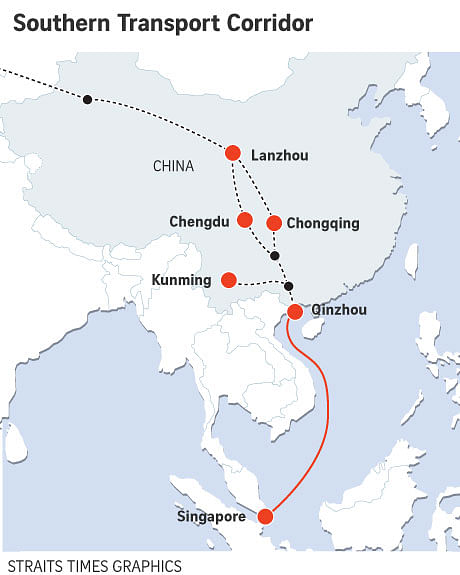QINZHOU (Guangxi) - Industrial cargo such as car parts, machinery and petrochemical products from western Chinese inland cities Chengdu and Chongqing now have an alternative route to be exported to Singapore and beyond.
They are transported via a railway network known as the Southern Transport Corridor (STC) to Qinzhou port in southern Guangxi and onward via more than a dozen shipping routes to overseas destinations.
Compared to the traditional route via the Yangtze River to Shanghai port, the STC cuts transit time within China from more than two weeks to just two days.
Plastic raw materials and paper pulp, on the other hand, are transported via this link from Singapore to Chongqing.
Deputy Prime Minister Teo Chee Hean, who is on a nine-day trip to China, visited the container port at the Beibu Gulf (Gulf of Tonkin) on Tuesday (July 3) as part of his tour of key nodes along the STC.
The STC, which now has the participation of 10 western and southern provinces, extends from the Chongqing Connectivity Initiative (CCI), the third joint project between China and Singapore.
Mr Teo was briefed on the developments of the port and took a tour around the port and the connecting railway station.

A joint venture company set up in 2015 by the local Beibu Gulf Port Group, Singapore port operator PSA International and Singapore shipping company Pacific International Lines (PIL) operates four out of six berths in the port.
Last year, it handled 430,000 20-foot equivalent unit (TEU) of cargo, and it aims to hit 1 million TEUs this year.
That annual capacity of the port is 3 million TEUs.
"The port is growing rapidly, we see a 30 per cent growth in our shipping volume every year since 2015," said Mr Teo Siong Seng, chairman of PIL, which has two sailings a week from Qinzhou to Singapore.
Currently, majority of the cargo flow is southbound, with agricultural raw materials from Guangxi and neighbouring Guizhou province, as well as industrial goods from Chengdu and Chongqing heading towards Qinzhou to be exported overseas.
Since the start of this rail freight service last September, there are now three weekly train trips to and from Chengdu to Qinzhou and four southbound trains and two northbound ones linking Chongqing and the port.
Trial operations from Lanzhou, capital city of western Gansu province and Kunming, capital city of south-western Yunnan province have started. And there are plans to encourage local players in the neighbouring cities to use the STC railway network.
On Tuesday, Mr Teo met Guangxi autonomous region chairman Chen Wu in the provincial capital of Nanning.
Mr Chen commented that Mr Teo had visited the province during an exceptionally hot period.
Mr Teo arrived in China last Thursday for a wide-ranging visit that saw him visit Beijing and Tianjin before travelling to southern Guangxi. He will visit south-western Chongqing on Wednesday before ending the trip on Thursday in Lanzhou city of western Gansu province.


